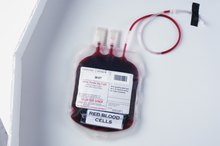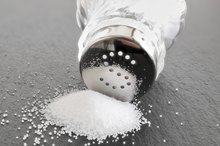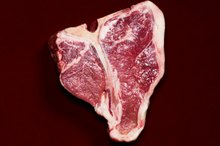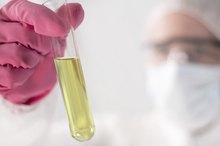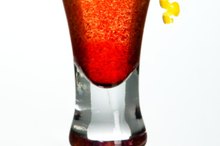How Does Alcohol Affect Blood pH?
PH is a term used to describe the relative acid content of blood and other fluids called solutions. In your bloodstream, pH is determined in part by the presence of a substance called phosphate. When you drink alcohol, it triggers changes in your phosphate levels that lead to increases in your blood pH.
Understanding pH
Human blood is a solution, which means that it has components with a uniform distribution inside a liquid. The pH scale, which ranges from 0 to 14 pH units, measures the concentration of electrically charged hydrogen atoms, also called hydrogen ions, inside your blood or any other solution. PH readings below 7.0 indicate the presence of an acidic blood environment, while pH readings above 7.0 indicate the presence of an alkaline environment. A pH reading of 7.0 indicates the presence of a neutral blood environment. Normal human blood pH is a slightly alkaline 7.4.
- Human blood is a solution, which means that it has components with a uniform distribution inside a liquid.
- The pH scale, which ranges from 0 to 14 pH units, measures the concentration of electrically charged hydrogen atoms, also called hydrogen ions, inside your blood or any other solution.
Kidneys and Phosphate
What Are the Three Buffer Systems in Body Fluid?
Learn More
Alcohol alters your blood pH by altering your kidneys’ ability to maintain your blood levels of electrically charged atoms, or ions, of a mineral called phosphate. Under normal circumstances, your kidneys balance your blood levels of phosphate ions against your levels of several additional types of mineral ions — including sodium, potassium, magnesium and chloride — that affect other aspects of your blood health. Imbalances of any of these substances can significantly degrade the effectiveness of your body’s overall metabolism.
Varying Pathways
When you drink a relatively diluted form of alcohol, such as beer, you consume a significant amount of water while simultaneously reducing your kidneys’ ability to efficiently get rid of that water, according to the University of Montana 3. The resulting fluid overload and alteration in phosphate levels triggers a decrease in the acidity of your blood, which means your pH level rises. When you drink more concentrated hard alcohol, you increase your kidneys’ ability to eliminate water. In turn, you concentrate your blood levels of phosphate, which also leads to an increase in your blood pH.
- When you drink a relatively diluted form of alcohol, such as beer, you consume a significant amount of water while simultaneously reducing your kidneys’ ability to efficiently get rid of that water, according to the University of Montana 3.
- In turn, you concentrate your blood levels of phosphate, which also leads to an increase in your blood pH.
Considerations
Electrolytes & Alcohol Abuse
Learn More
A single drink of alcohol can trigger alterations in your normal kidney function, the University of Montana reports 3. If previous alcohol consumption has damaged your liver, alcohol’s harmful effects on your kidneys will increase. Humans are sensitive to changes in blood pH, and pH levels above 7.8 or below 6.8 can kill you. Under normal circumstances, your body uses phosphate in a system of chemical buffers designed to combat any significant changes in blood pH. However, hard alcohol in particular decreases the effectiveness of the buffer system. Consult your doctor for more information on the kidney- and pH-related effects of alcohol consumption.
- A single drink of alcohol can trigger alterations in your normal kidney function, the University of Montana reports 3.
- Under normal circumstances, your body uses phosphate in a system of chemical buffers designed to combat any significant changes in blood pH.
- However, hard alcohol in particular decreases the effectiveness of the buffer system.
Related Articles
References
- Biology Online: pH Scale
- Biology Online: Solution
- Washington University in St. Louis; Blood, Sweat, and Buffers: pH Regulation During Exercise; Rachel Casiday, Regina Frey
- Taylor B, Rehm J. The relationship between alcohol consumption and fatal motor vehicle injury: high risk at low alcohol levels. Alcohol Clin Exp Res. 2012;36(10):1827-34. doi:10.1111/j.1530-0277.2012.01785.x
- Ferré S, O'Brien MC. Alcohol and caffeine: The perfect storm. J Caffeine Res. 2011;1(3):153-162. doi:10.1089/jcr.2011.0017
- Stornetta A, Guidolin V, Balbo S. Alcohol-derived acetaldehyde exposure in the oral cavity. Cancers (Basel). 2018;10(1):20. doi:10.3390/cancers10010020
- Hadland SE, Levy S. Objective testing: Urine and other drug tests. Child Adolesc Psychiatr Clin N Am. 2016;25(3):549-65. doi:10.1016/j.chc.2016.02.005
- Stewart SH, Koch DG, Willner IR, Randall PK, Reuben A. Hair ethyl glucuronide is highly sensitive and specific for detecting moderate-to-heavy drinking in patients with liver disease. Alcohol Alcohol. 2013;48(1):83-7. doi:10.1093/alcalc/ags109
- Fillmore MT, Jude R. Defining "binge" drinking as five drinks per occasion or drinking to a .08% BAC: which is more sensitive to risk? Am J Addict. 2011;20(5):468-75. doi:10.1111/j.1521-0391.2011.00156.x
- American Association for Clinical Chemistry. Ethanol. 2018.
- Cederbaum A. Alcohol metabolism. Clinics in Liver Disease. 2012;16(4):667-685. doi:10.1016/j.cld.2012.08.002
- LabCorp, Inc. Drugs of Abuse Reference Guide. 2007.
- National Institute on Alcohol Abuse and Alcoholism. Alcohol Metabolism: An Update. Alcohol Research & Health. 2007;30(1).
Writer Bio
M. Gideon Hoyle is a writer living outside of Houston. Previously, he produced brochures and a wide variety of other materials for a nonprofit educational foundation. He now specializes in topics related to health, exercise and nutrition, publishing for various websites.
